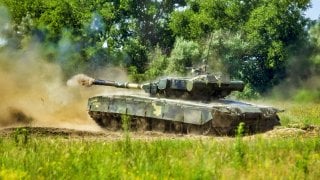Russia's T-80 Tank Keeps 'Getting Blown to Bits' in Ukraine
Russia's invasion of Ukraine has resulted in significant tank losses, prompting the Russian army to deploy older models like the T-80 to supplement its forces.
What You Need to Know: Russia's invasion of Ukraine has resulted in significant tank losses, prompting the Russian army to deploy older models like the T-80 to supplement its forces.

-Introduced in the late 1970s, the T-80 features a gas turbine engine that provides exceptional speed but suffers from high fuel consumption and reliability issues.
-Historically, the T-80 underperformed in conflicts like the Chechen Wars due to poor crew training and tactical deployment.
-In Ukraine, Russia may use the T-80 as mobile artillery or support units, especially as Ukraine faces ammunition shortages, as has occurred in the past. While not without flaws, the T-80 could still impact the battlefield if employed effectively amid current resource constraints.
Russia's T-80 Tank: An Old Weapon Making a Difference in Ukraine?
Russia’s 2022 invasion of Ukraine began the largest land conflict in Europe since the Second World War. And just as they did in that 20th century war, tanks have played a leading role in the fields of Eastern Ukraine.
When you use tanks you will lose them, and Russia’s armored units in particular have suffered serious attrition. Open-source defense blog Oryx estimates that Russia has lost more than 2,800 tanks to date as of the summer. In one struggle alone, the Battle of Vuhledar, Ukrainian commanders believe they knocked out more than 130 Russian tanks and armored personnel carriers as of May figures, with that number likely higher.
As the war drags on, the Russian army has turned to stocks of older tanks to supplement its forces. One such vehicle is the T-80.
The History of T-80 Main Battle Tank for Russia
In the 1960s, the Soviet Union produced the T-64, a new heavy tank. Soviet designers were already working on using gas turbine engines to power a tank. That vision joined with a design based on the T-64 to create the T-80.
The T-80 had a crew of three, one fewer than usual. Instead of having a loader in the crew, an autoloader fed rounds into the 125mm smoothbore cannon. While subtracting one crew position from the tank decreased its weight, it had the drawback of being much more dangerous. Several unlucky gunners lost their arms to the autoloader in the close confines of the interior. Furthermore, the autoloader displaced ammunition storage to the outside of the turret, which greatly reduced survivability in the event of a hit. Many videos from Ukraine show tanks with their turrets “popped” as the ammunition cooked off inside the tank.

Perhaps the biggest drawback of the T-80 was its newfangled gas turbine engine. The engine did provide outstanding speed and maneuverability, and the Soviets boasted that the T-80 was their “English Channel tank,” a vehicle that would get from Germany to the Channel in five days in the event of a war with NATO. In reality, however, they consumed far too much fuel, even at idle, to be an effective spearhead vehicle. The finicky engine was far from reliable and often succumbed to dust or dirt in the fuel.
In spite of these problems, and even a cancellation of the program by the minister of defense in 1974, in 1976 a new minister approved production, and T-80s began rolling off the line at the Omsktransmash plant a few years later. Since then, they have been exported and upgraded, and many T-80 variants are still in service today with nations around the world.
Specs & Capabilities for T-80 Tank
Throughout the years, the Soviet Union and later Russia have upgraded the T-80 in a bid to keep it relevant. As soon as the early 1980s, just a few years after it entered production, the tank received a new engine. The first major upgrade occurred in 1985, when manufacturers began installing Kontakt-1 explosive reactive armor designed to detonate anti-tank missiles before they reach the tank itself. Upgrades since then have mainly prioritized the T-80’s optics, fire control, and weapons systems.
Operational History and Why it Matters
Despite being designed for a major conflict with the West, the T-80 first saw combat in Chechnya in 1994. During that war, the tank seriously underperformed, suffering many losses of both vehicles and crews. Much of the combat took place in an urban environment where the T-80’s poor ability to train its gun up high hampered its abilities. Often, T-80s were crewed by inexperienced service members and unsupported by infantry, which is usually a death sentence for a tank.

Critics decried the tank as inadequate, while supporters pointed to its poor employment as the reason for losses. Many of these issues seem to be present still in how and where the T-80 finds itself in Ukraine.
How Can They Be Used in Ukraine?
In light of the struggles facing Russian tanks in Ukraine, and the potential inadequacies of the T-80, how might the Russian army use them in Ukraine? The simplest solution would be to keep them as “mobile artillery” capable of supporting infantry from a distance without being exposed to counterfire.
Better training of crews or upgrades to its defensive systems may improve its performance in attacks, but this takes time and resources, both of which are in short supply in Russia at the moment.

About the Author: Maya Carlin
Maya Carlin, National Security Writer with The National Interest, is an analyst with the Center for Security Policy and a former Anna Sobol Levy Fellow at IDC Herzliya in Israel. She has by-lines in many publications, including The National Interest, Jerusalem Post, and Times of Israel. You can follow her on Twitter: @MayaCarlin. Email the author: [email protected].
All images are Creative Commons.


